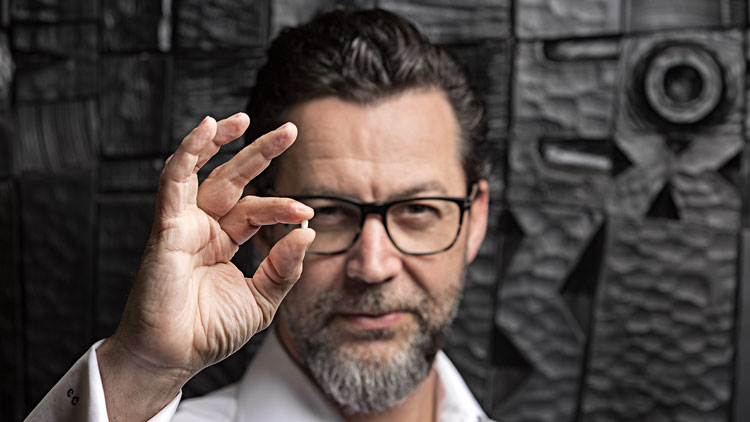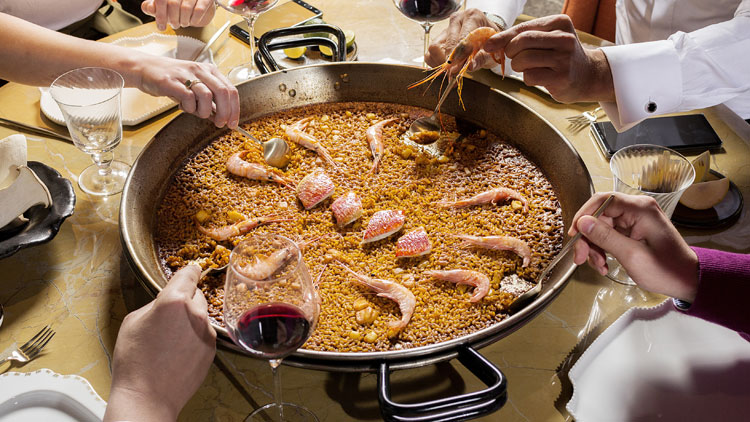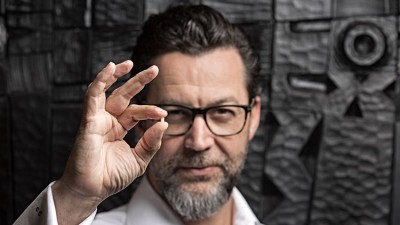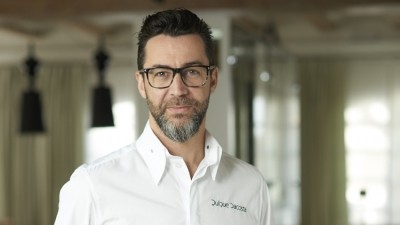The Rice Man cometh: how Quique Dacosta is shaking up Spanish food in the capital
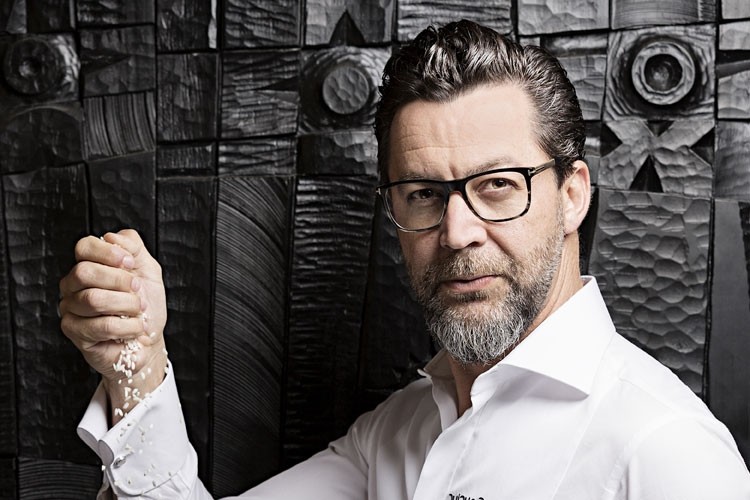
Immaculately dressed in chef ‘whites’, which in this case is a freshly ironed fitted white shirt, Quique Dacosta is standing in front of a blazing hot wood-fired stove in the open kitchen of his new Fitzrovia restaurant Arros QD. The lick of flames dances in the reflection of his black and cream rimmed glasses as he animatedly describes the paella-making process that is going on in front of us.
He oversees as head chef Richard De La Cruz puts pieces of monkfish and cuttlefish into the sizzling oil of a huge paella pan held above the flames by a bespoke frame fashioned out of stainless steel. Rice is added and the mixture is given a deft stir with a wide slotted spoon to sweat it in the oil until it is transparent. In goes a sofrito of tomato, saffron and smoked paprika, which is quickly mixed into the rice before a few litres of stock are added to the pan. Cue more stirring, then the rice is left to bubble away so that it soaks up all of the stock, sticking slightly to the pan to caramelise the base as it cooks.
The final flourish is four large carabineros prawns, which are placed evenly in the middle of the pan, under which some twigs of pine are quickly added, bringing the flames to a raging crackle. The paella is cooked for only a fleeting moment more before the bubbling mixture is taken off the heat and placed on the pass for everyone to try.
A rice-focused restaurant
Arros QD, the large restaurant in which we are standing, is unusual for a number of reasons. First, we are testing dishes in a fully kitted-out kitchen and restaurant – aside from a few missing lampshades and minor fixtures – despite it not opening for at least another month, which makes a refreshing change from conducting an interview in a building site a week before the planned opening date, as is often the case. Then there’s the fact that, as the name implies, this is a restaurant devoted almost entirely to rice, and in particular the Valencian dish paella (Dacosta has chosen to use the Valencian spelling of the word for his restaurant’s name) – a dish that isn’t commonly championed in the UK beyond a smattering of Spanish restaurants. When it is served, paella is routinely abused and seldom cooked from scratch and served immediately, which is essential for such a dish.
And, of course, there’s Dacosta himself, a three Michelin-starred chef whose eponymous restaurant in Denia, eastern Spain, has spent a long time on the World’s 50 Best Restaurants list (it currently sits at number 61 in the Top 100 list) and has helped to break culinary ground in the same way as places such as ElBulli. The smart, bespectacled chef joins Spanish contemporaries Juan Mari Arzak and his daughter Elena, David Muñoz and Eneko Atxa, chefs behind three-Michelin starred venues that have opened restaurants in the UK capital in the past decade. It’s probably fair to say that neither Ametsa with Arzak Instruction at The Halkin hotel, Street XO, or Eneko at One Aldwych hotel has set the capital’s culinary scene alight as its owners may have expected, so will Dacosta fare any better?
Whether Londoners will embrace a restaurant of such a singular focus is in the lap of the gods, but with Arros QD Dacosta isn’t straying from his expertise. While – sensibly – understanding that his particular brand of cutting-edge techno-emotional cooking he serves up in Denia might not exactly be what Londoners are looking for at the moment, he is sticking to what he knows. And Dacosta knows his rice. So much so that he’s written a 300-page book dedicated to it (called Arroces Contemporáneos). He’s also already made the move into more casual territory in his homeland with Llisa Negra, where much of the food is cooked on a wood-burning stove. What’s more, he has inside knowledge of the UK eating-out market in that Arros QD is a collaborative project with Marcos Fernandez Pardo, CEO of Spanish restaurant group Ibérica and CEO of InPaella, the company that is overseeing the new joint venture.
Even still, why rice-focused, why London and why now for his first restaurant outside of Spain, apart from a pop-up in Dubai called Enigma three years ago? “It’s been a dream of mine for a long time. I’ve always liked the idea of doing traditional Spanish recipes,” says Dacosta, adding that he has been looking for a suitable restaurant site for the past three years. Surely it can’t have taken that long to find a central London site in the current climate? “It does if you need the extraction that a restaurant such as this has,” chimes in Pardo, describing how the vast extraction system at the restaurant is a feat of modern engineering (a later conversation with ventilation experts Chapman Ventilation confirms this). “We have had to look for a very long time to find a site suitable and big enough for what we want to do here.”
Dacosta recognises that he is focusing on a traditional Spanish dish that is loved in Spain and by visitors to the country but almost forgotten about when they return to home turf. It is this mindset that he is hoping to change.
“I don’t think it will take a lot of education for people to understand how great paella is as a dish that can be eaten all the time,” he says. “Many people have tried it when they visit Spain or have been exposed to it, they already know about the dish. We are here to give our grain of rice to London and to show people how great it can be.”
It won’t be without its challenges. Spanish group Brindisa attempted something similar in Shoreditch with Tramontana, which served rice dishes freshly cooked to order, but later reverted to its Tapas Brindisa format.
Moreover, Dacosta insists that, despite its paella focus, Arros QD isn’t a Spanish restaurant at all: “I consider it to be a contemporary English restaurant that does paella.”
Where modernity and tradition meet
However Dacosta wants to classify Arros QD, it’s not just its name that tells the diner that rice will be in their immediate future. When you enter the restaurant – 140 covers in total set across a ground floor and an upstairs bar and dining room – you’re met with paella-making paraphernalia that sets it apart from most other restaurants. There’s a large open kitchen, complete with an eight-metre flame grill in which paella pans sit above burning piles of wood. To the left is another grill, more typical of what you might find in a restaurant kitchen, on which other meat and fish dishes will be cooked. To the right is a large Kamado Joe, which will be used for smoking.
Surrounding the open kitchen is a counter where diners can sit and watch the chefs at work, and directly in front of them are five huge state-of-the-art gas-fired paella burners, on which some of the restaurant’s paellas will be cooked. Here is a kitchen where the disparity between modernity and tradition is marked.
“The technology in the kitchen goes from the rudimentary to the extreme,” says Pardo, explaining the modern paella burners were chosen for their ability to cook consistently. The kit in question is Mimcook, which its maker describes as ‘the first high-precision paella maker for professional kitchens’. Not only does it have sensors that measure the humidity and heat of the rice as it cooks, but it regulates each burner to ensure the ideal temperature over the whole paella pan at every stage, taking into account environmental conditions, weight, time and flame height, to guarantee the correct cooking of each grain. Moreover, any recipe can be memorised and reproduced in the same way every time.
But there’s more to cooking paella than sticking it on a gas burner and pressing play. While some paellas don’t benefit from being cooked over wood, some do, and Dacosta is keen to showcase the skill and attention to detail required to make these paellas, which include the traditional Valnecian paella and some vegetarian ones, where the smoke enhances the flavour. This is where the open flame grill comes in.
Different woods are used for different styles of dishes, for example, and for different parts of the cooking process. “A paella dish has its own wood, whether it be olive, orange, palm or holm oak (the trees that supply the acorns on which Iberian pigs feed),” says Dacosta. “The wood is important, not just for combustion but for aroma and flavour. Smoke for rice is like air for ice cream. Without air there is no ice cream. Air is the most used ingredient in cooking, just as silence is the note most used in music. Rice is a conductor of flavour. It is not an ingredient; it’s the dish.”
The way different woods burn is taken into account. The paella-making process might start with it being cooked over the wood from olive trees, but it may be finished with the addition of cuttings from vine trees, which are very thin and burn quickly and in a very lively fashion, helping dry out the paella during the vital latter stages. “When it starts to sing it is nearly ready,” says Dacosta of the sound a drying-out paella makes in the pan.
The type of rice will also dictate the consistency of the final dish. While more classic paellas are described as seco, meaning dry, other rice dishes can be caldoso, which has a more soupy texture, and meloso, which is more sticky and risotto-like. Dacosta says he has spent two years selecting the exact rice he requires for each dish, with around a dozen different types being used. For a coldoso-style dish he uses bomba rice, which takes in a lot of the flavour from the stock but doesn’t lose its starch which would otherwise thicken the dish. For meloso dishes, he would use a rice that does lose its starch to create a more sticky texture.
But whatever rice is used, and whatever heat source, he has a golden rule: “The rice should be evenly distributed in the pan so it’s very important it’s very flat, otherwise it won’t dry out evenly. And when it’s boiling don’t touch it. You need to let the rice caramelise on the bottom of the pan.”
The menu
Traditional rice dishes on the Arros QD menu will include an Iberian secreto and black garlic aioli; a classic Valencian paella of rabbit, chicken and butter beans; and a cuttlefish and lobster option. There will also be a caldoso-style octopus and lobster rice hotpot – with all dishes for a minimum of two people. All paellas are served directly to the table, with the hot pans (the restaurant has 73 of them at £40 each) placed into a stainless steel holder.
Starting at £32 for the classic paella and topping out at £110 for the hotpot, even the most expensive menu item won’t break the bank if split three ways (which each could easily do as part of a meal). But what of solo diners or those who don’t want to share the same dish? For these eventualities Dacosta has created rice in ‘chapas’, smaller rectangular serves of rice for one person with more contemporary options on offer, including one made with duck breast, wild mushrooms and porcini aioli; another with dashi and mackerel and black garlic aoili; and an ash rice with black truffle (priced at £11-£29). Grill dishes, meanwhile, will include a Cornwall tomahawk steak; aged rib-eye with chimichurri; whole brill; glazed pork ribs; and wild mushrooms.
“The idea is that you can come in with a group of people and order a large rice dish to share and then some grill dishes,” says Pardo. “Or you can come in on your own and have one of the chapas and a glass of wine. It’s a restaurant that embraces different occasions. We know that not everyone is going to want to come in and share a large rice dish, especially at lunch.” With the chapas only taking around seven minutes to cook in an oven, they also put Arros QD into the express lunch territory.
All this notwithstanding, the three-star chef hasn’t been able to resist bringing to London the culinary flourishes for which he is held in such high regard in Spain. One suspects that it is with his menus of para picar and entradas that he still might generate the most excitement. Para picar dishes include a manchego stone made with parmesan, manchego cream and cocoa butter; a truffle bomb of liquid potato souffle and truffle ‘spaghetti’; and a deep-fried cassava with ‘pericana’ emulsion of red peppers, cod, garlic and olive oil.
Larger entrada dishes, meanwhile, will include pulled pork sliders with kimchi; stone bass ceviche; soft shell crab with spicy mayo; beef cheeks in a red curry stew; and smoked oysters with shiso leaves and coconut dressing. Signature desserts will include a giant cookie with Macademia nut and Araguani chocolate; and cheesecake, almond paper, forest fruit syrup and biscuit ice cream.
While they may sound as if they’ve been plucked from Dacosta’s Denia playbook, many of these dishes have been created for London, he insists, and are a vital part of the meal.
“When you eat paella it’s a real sharing thing. It’s a very happy dish, a very weekend dish that you have when you invite your family round and it’s eaten straight from the pan. But you must have starters first, then paella and then meat or fish – the rice is never eaten at the beginning of the meal, always in the middle.”
The restaurant space
Just as Dacosta doesn’t want Arros QD to be regarded as a Spanish restaurant – although he is likely to have his work cut out convincing people otherwise – to eat in the restaurant isn’t to be taken back to that holiday in Spain. The dining room, designed by Barcelonian studio Lázaro Rosa-Violán, eschews any whitewash and bright colours for a much darker and moodier colour palette.
“We didn’t want it to look Mediterranean, that’s a bad contrast when you’re sitting inside in winter and it’s raining outside,” says Dacosta. Instead, the decor is meant to mirror the fire of the central kitchen, with oranges, reds, browns, black and gold reflecting the colours of wood, flames and burning embers.
Upstairs is more of the same, with a bar area to the right as you ascend the curved dark staircase. A second dining room to the left is decked out in a slightly lighter colour palette
in a bid to broaden the restaurant’s appeal.
Despite the restaurant already being a sizeable 140 covers, it could in time become even bigger. The building in which Arros QD is housed is vast, so much so that not only is the kitchen area about the same size as the dining space but its back-of-house areas are almost hotel like. So big is the space that some of it remains unused due to budget restrictions – over time the intention is to extend the upstairs dining room so that it spans the top floor space, says Pardo, when finances allow.
Thus Pardo and Dacosta are very much in this for the long haul, as the scale of investment suggests. This is not a consultancy, Dacosta says, it’s very much his project and he will make regular trips to London to be there. At launch he says he’ll spend a lot of time at the restaurant but, following that, he will visit every couple of weeks.
“London is a good environment to be in,” he says. “It’s dynamic. We can only learn from it. I’ll learn more than I’ll teach here.”
Who is Quique Dacosta?
Once described as a modernist master who challenges perceptions of Mediterranean food, Quique Dacosta has long been a standard bearer for Spain’s modernist movement. He is a master of techno-emotional cooking, capturing the essence of the Mediterranean in technical avant-garde dishes that contextualises Alicantine, Valencian and Spanish innovative food at his three-Michelin-starred restaurant in Dénia, Alicante province.
Born in 1972 in Jarandilla de la Vera in Extremadura, western Spain, he began his career as a chef in 1986 at the age of 14, working in various kitchens. Dacosta started at El Poblet – a family-run seafood restaurant in Valencia – when he was 17, working his way up to head chef, before taking over the business entirely in 1999. In 2002 the restaurant received its first Michelin star, with a second being awarded in 2006. In 2009, Dacosta renamed El Poblet as Quique Dacosta and the restaurant won its third star in 2013.
El Poblet was reincarnated in 2012 in the centre of Valencia, with Dacosta using the original restaurant’s lettering within the restaurant. The fine dining restaurant, whose current dishes include cauliflower, eel emulsion and caviar; sweet potato skin, foie gras and malt Scotch whisky; and red king prawn with Swiss chard tea, won a Michelin star in 2013.
Other venues in his growing portfolio include Mercat Bar, where he serves a modern interpretation of classic tapas dishes, and Vuelve Carolina, a restaurant that combines tradition and innovation in global cuisine, with a Peruvian bar menu and a tapas and taco à la carte menu alongside a number of set menus.
His latest venture, Llisa Negra, opened in Valencia in November and is more casual, with an open kitchen and a menu that has a grill focus. Dishes served here include steak with mashed potatoes; grilled cod with asparagus; and grilled artichoke tatin.
“Cuisine wraps you up, it embraces you. It gives and takes away, yet it also seduces and enamours you,” is how Dacosta describes his cooking. “When you look around and realise there’s no turning back, you have become her captive. Yet beyond this sacrifice, effort or dedication, we have brought dignity to the profession, working toward this goal every day. Living and developing under the sanctuary of a restaurant is something else, and this is what we show the world.”
This is a web version of an article that first appeared in the May issue of Restaurant magazine, the leading title for the UK's restaurant industry. For more features, comment, interviews and in-depth analysis of the restaurant sector subscribe to Restaurant magazine here.
